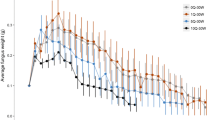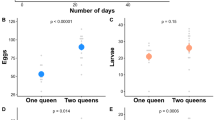Abstract
Pleometrosis (colony founding by multiple queens) may improve life history characteristics that are important for early colony survival. When queens unite their initial brood, the number of workers present when incipient colonies open may be higher than for single queen colonies. Further, the time until the first worker emerges may shorten. For territorial species and species that rob brood from neighbouring colonies, a faster production of more workers may improve the chance of surviving intraspecific competition. In this study, the time from the nuptial flight to the emergence of the first worker in incipient Oecophylla smaragdina Fabr. colonies founded by 1–5 queens was compared and the production of brood during the first 68 days after the nuptial flight was assessed. Compared to haplometrotic colonies, pleometrotic colonies produced 3.2 times more workers, their first worker emerged on average 4.3 days (8%) earlier and the queen’s per capita egg production almost doubled. Further, colony production was positively, correlated with the number of founding queens and time to worker emergence was negatively correlated. These results indicate that pleometrotic O. smaragdina colo-nies are competitively superior to haplometrotic colonies as they produce more workers faster and shorten the claustral phase, leading to increased queen fecundity.

Similar content being viewed by others
References
Adams E.S. and Tschinkel W.R. 1995a. Effects of foundress number on brood raids and queens survival in the fire ant Solenopsis invicta. Behav. Ecol. Sociobiol. 37: 233-242
Adams E.S. and Tschinkel W.R. 1995b. Spatial dynamics of colony interactions in young populations of the fire ant, Solenopsis invicta. Oecologia 102: 156-163
Baldacci J. and Tschinkel W.R. 1999. An experimental study of colony founding in pine saplings by queens of the arboreal ant, Crema-togaster ashmeadi. Insect. Soc. 46: 41-44
Bartz S.H. and Hölldobler B. 1982. Colony founding in Myrmeco-cystus mimicus Wheeler (Hymenoptera, Formicidae) and the evolution of foundress-associations. Behav. Ecol. Sociobiol. 10: 137-147
Bernasconi G. and Strassmann J.E. 1999. Cooperation among unrelated individuals: the ant foundress case. Trends Ecol. Evol. 14: 477-482
Brown M.J.F. 2000. From the laboratory to the field: the advantage of pleometrotic colony founding. Trends Ecol. Evol. 15: 116
Børgesen L. and Jensen P.V. 1995. Influence of larvae and workers on egg production of queens of the pharaohs ant, Monomorium pharaonis (L). Insect. Soc. 42: 103-112
Cassill D.L. and Vinson S.B. 2007. Effects of larval secretions on queen fecundity in the fire ant. Ann. Entomol. Soc. Amer. 100: 327-332
Gadau J., Strehl C.P., Oettler J. and Hölldobler B. 2003. Determinants of intracolonial relatedness in Pogonomyrmex rugosus (Hymenoptera; Formicidae): mating frequency and brood raids. Mol. Ecol. 12: 1931-1938
Gibson R.L. and Scott J.G. 1990. Influence of cocoons on egg laying of colony founding carpenter ant queens (Hymenoptera, Formicidae). Ann. Entomol. Soc. Amer. 83: 1005-1009
Hahn D.A. and Tschinkel W.R. 1997. Settlement and distribution of newly-mated queens of the arboreal ant, Crematogaster ashmeadi, in a longleaf pine forest. Insect. Soc. 44: 323-336
Hölldobler B. and Carlin N.F. 1985. Colony founding, queen dominance and oligogyny in the Australian meat ant Iridomyrmex purpureus. Behav. Ecol. Sociobiol. 18: 45-58
Hölldobler B. 1983. Territorial behavior of the green tree ant (Oecophylla smaragdina). Biotropica 15: 241-250
Hölldobler B. and Wilson E.O. 1990. The Ants. Springer-Verlag, Berlin Heidelberg
Johnson R.A. 2004. Colony founding by pleometrosis in the semiclaustral seed-harvester ant Pogonomyrmex californicus (Hymenoptera: Formicidae). Anim. Behav. 68: 1189-1200
Krag K., Lundegaard R., Offenberg J., Nielsen M.G. and Wiwatwittaya D. 2010. Intercolony transplantation of Oecophylla smaragdina (Hymenoptera: Formicidae) larvae. J. Asia-Pacific Entomol. 13: 97-100
Kronauer D.J.C., Gadau J. and Hölldobler B. 2003. Genetic evidence for intra- and interspecific slavery in honey ants (genus Myrme-cocystus). Proc. R. Soc. B 270: 805-810
Mintzer A.C. 1987. Primary polygyny in the ant Atta texana - number and weight of females and colony foundation success in the laboratory. Insect. Soc. 34: 108-117
Offenberg J., Peng R., Nielsen M.G. and Birkmose D. The effect of queen and worker adoption on weaver ant (Oecophylla smaragdina F.) queen fecundity. J. Insect Behav. doi:10.1007/s10905-011-9311-7
Peeters C. and Andersen A.N. 1989. Cooperation between dealate queens during colony foundation in the green tree ant Oecophylla smaragdina. Psyche 96: 39-44
Peng R.K., Christian K. and Gibb K. 1998. How many queens are there in mature colonies of the green ant, Oecophylla smaragdina (Fabricius)? Aust. J. Entomol. 37: 249-253
Peng R.K., Christian K. and Gibb K. 1999. The effect of colony isolation of the predacious ant, Oecophylla smaragdina (F.) (Hymenoptera: Formicidae), on protection of cashew plantations from insect pests. Int. J. Pest Manag. 45: 189-194
Porter S.D. and Tschinkel W.R. 1986. Adaptive value of nanitic workers in newly founded red imported fire ant colonies (Hymenoptera: Formicidae). Ann. Entomol. Soc. Amer. 79: 723 726
Rice W.R. 1989. Analyzing tables of statistical tests. Evolution 43: 223-225
Rissing S.W. and Pollock G.B. 1987. Queen aggression, pleometrotic advantage and brood raiding in the ant Veromessor pergandei (Hymenoptera, Formicidae). Anim. Behav. 35: 975-981
Rissing S.W. and Pollock G.B. 1991. An experimental analysis of pleometrotic advantage in the desert seed harvester ant Messor pergandei (Hymenoptera, Formicidae). Insect. Soc. 38: 205-211
Sasaki K., Jibiki E., Satoh T. and Obara Y. 2005. Queen phenotype and behaviour during cooperative colony founding in Polyrhachis moesta. Insect. Soc. 52: 19-25
Sommer K. and Hölldobler B. 1995. Colony founding by queen association and determinants of reduction in queen number in the ant Lasius niger. Anim. Behav. 50: 287-294
Strassmann J.E. 1989. Altruism and relatedness at colony foundation in social insects. Trends Ecol. Evol. 4: 371-374
Tschinkel W.R. 1988. Social control of egg laying rate in queens of the fire ant, Solenopsis invicta. Physiol. Entomol. 13: 327-350
Tschinkel W.R. 1992a. Brood raiding and the population dynamics of founding and incipient colonies of the fire ant, Solenopsis invicta. Ecol. Entomol. 17: 179-188
Tschinkel W.R. 1992b. Brood raiding in the fire ant, Solenopsis invicta: laboratory and field observations. Ann. Entomol. Soc. Amer. 85: 638 646
Tschinkel W.R. and Howard D.F. 1983. Colony founding by pleo-metrosis in the fire ant, Solenopsis invicta. Behav. Ecol. Sociobiol. 12: 103-113
Waloff N. 1957. The effect of the number of queens of the ant Lasius flavus (Fab.) (Hym., Formicidae) on their survival and on the rate of development of the first brood. Insect. Soc. 4: 391-408
Acknowledgments
The collection of weaver ant queens for this study was supported by a grant from the Carlsberg Foundation (2009-01-0406) and by Professor Keith Christian. Thanks to Charles Darwin University for providing necessary facilities. The comments from two anonymous reviewers improved this paper.
Author information
Authors and Affiliations
Corresponding author
Rights and permissions
About this article
Cite this article
Offenberg, J., Peng, R. & Nielsen, M.G. Development rate and brood production in haplo- and pleometrotic colonies of Oecophylla smaragdina . Insect. Soc. 59, 307–311 (2012). https://doi.org/10.1007/s00040-012-0221-2
Received:
Revised:
Accepted:
Published:
Issue Date:
DOI: https://doi.org/10.1007/s00040-012-0221-2




